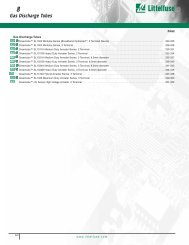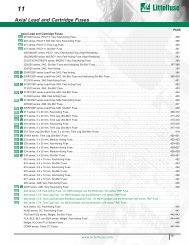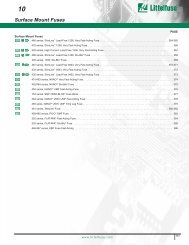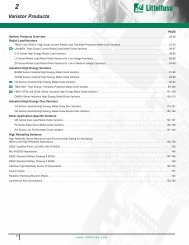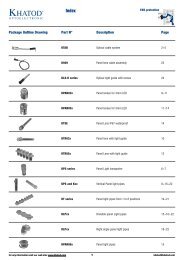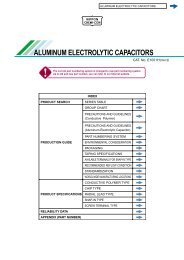TVS Diode Arrays
TVS Diode Arrays
TVS Diode Arrays
You also want an ePaper? Increase the reach of your titles
YUMPU automatically turns print PDFs into web optimized ePapers that Google loves.
<strong>TVS</strong> <strong>Diode</strong> <strong>Arrays</strong><br />
Electronic Protection Array for ESD and Overvoltage Protection<br />
SP723<br />
Peak Transient Current Capability of the SP723<br />
The peak transient current capability rises sharply as the width of the<br />
current pulse narrows. Destructive testing was done to fully evaluate the<br />
SP723’s ability to withstand a wide range of peak current pulses vs time.<br />
The circuit used to generate current pulses is shown in Figure 5.<br />
The test circuit of Figure 5 is shown with a positive pulse input. For a<br />
negative pulse input, the (-) current pulse input goes to an SP723 ‘IN’<br />
input pin and the (+) current pulse input goes to the SP723 V- pin. The<br />
V+ to V- supply of the SP723 must be allowed to float. (i.e., It is not tied<br />
to the ground reference of the current pulse generator.) Figure 6 shows<br />
the point of overstress as defined by increased leakage in excess of the<br />
data sheet published limits.<br />
The maximum peak input current capability is dependent on the ambient<br />
temperature, improving as the temperature is reduced. Peak current<br />
curves are shown for ambient temperatures of 25 o C and 105 o C and a 15V<br />
power supply condition. The safe operating range of the transient peak<br />
current should be limited to no more than 75% of the measured overstress<br />
level for any given pulse width as shown in the curves of Figure 6.<br />
Note that adjacent input pins of the SP723 may be paralleled to improve<br />
current (and ESD) capability. The sustained peak current capability is<br />
increased to nearly twice that of a single pin.<br />
PEAK CURRENT (A)<br />
14<br />
12<br />
10<br />
8<br />
6<br />
4<br />
2<br />
T A = 105 o C<br />
T A = 25 o C<br />
0<br />
0.001 0.01 0.1 1<br />
PULSE WIDTH TIME (ms)<br />
+<br />
VX -<br />
www.littelfuse.com<br />
R 1<br />
VOLTAGE<br />
PROBE<br />
R1 ~ 10Ω TYPICAL<br />
VX ADJ. 10V/A TYPICAL<br />
C1 ~ 100µF<br />
(+)<br />
VARIABLE TIME DURATION<br />
CURRENT PULSE GENERATOR<br />
CURRENT<br />
SENSE<br />
1<br />
2<br />
3<br />
4<br />
IN<br />
IN<br />
IN<br />
V-<br />
V+<br />
IN<br />
SP723<br />
IN<br />
IN<br />
FIGURE 5. TYPICAL SP723 PEAK CURRENT TEST CIRCUIT<br />
WITH A VARIABLE PULSE WIDTH INPUT<br />
CAUTION: SAFE OPERATING CONDITIONS LIMIT<br />
THE MAXIMUM PEAK CURRENT FOR A GIVEN<br />
PULSE WIDTH TO BE NO GREATER THAN 75%<br />
OF THE VALUES SHOWN ON EACH CURVE.<br />
V+ TO V- SUPPLY = 15V<br />
FIGURE 6. SP723 TYPICAL SINGLE PULSE PEAK CURRENT CURVES SHOWING THE MEASURED POINT OF OVERSTRESS IN<br />
AMPERES vs PULSE WIDTH TIME IN MILLISECONDS<br />
10<br />
8<br />
7<br />
6<br />
5<br />
(-)<br />
C1<br />
100 1000<br />
+<br />
-<br />
243<br />
5<br />
<strong>TVS</strong> DIODE ARRAYS





